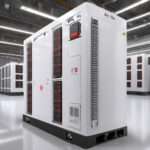Supercomputer Shows Black Hole Cracking Neutron Star in Final Explosive Seconds
In a major breakthrough, scientists have simulated in unprecedented detail how a neutron star cracks under the intense gravitational pull of a black hole in its final explosive seconds. This remarkable feat was achieved through the utilization of a supercomputer, which meticulously calculated the intricate dynamics of this cosmic event.
The simulation depicted the neutron star being stretched and distorted as it spiraled closer to the black hole. The immense tidal forces exerted by the black hole caused the neutron star to crack, releasing a burst of energy that rippled through the fabric of spacetime. This phenomenon, known as a tidal disruption event, is a rare but awe-inspiring occurrence in the universe.
By harnessing the computational power of a supercomputer, scientists were able to model the complex interplay of forces at play during this cataclysmic event. The simulation provided valuable insights into the behavior of matter under extreme conditions, shedding light on the nature of black holes and neutron stars.
This groundbreaking research not only deepens our understanding of the fundamental physics governing the cosmos but also highlights the critical role that technology plays in pushing the boundaries of scientific exploration. Supercomputers have become indispensable tools for simulating complex phenomena that are beyond the reach of traditional experimental methods.
The ability to recreate such events in a virtual environment opens up new possibilities for studying the behavior of matter under extreme conditions. Scientists can now test theoretical models, validate hypotheses, and explore scenarios that would be impossible to observe directly in nature. This paves the way for new discoveries and advances in our quest to unravel the mysteries of the universe.
The implications of this simulation extend far beyond the realm of astrophysics. The techniques and methodologies developed in this study can be applied to a wide range of fields, from materials science to climate modeling. The computational tools used to simulate the cracking of a neutron star can be adapted to solve complex problems in various disciplines, driving innovation and progress in diverse areas of research.
As we continue to unlock the secrets of the cosmos through the synergy of advanced technology and scientific inquiry, we are reminded of the boundless potential that lies within our reach. The simulation of a black hole cracking a neutron star serves as a testament to human ingenuity and the insatiable curiosity that drives us to explore the unknown.
In conclusion, the groundbreaking simulation conducted with a supercomputer has provided unprecedented insights into the final moments of a neutron star as it succumbs to the immense gravitational forces of a black hole. This achievement not only advances our understanding of the universe but also showcases the power of technology to illuminate the darkest corners of space.
supercomputer, neutron star, black hole, simulation, scientific breakthrough












